|
Knights’ New Dawn
As HUMAN HISTORY entered the eighteenth century, changes were
occurring.
The Inquisition was almost dead and the Bubonic Plague was
dying with it.
Students of
Masonic history know that the early 1700’s were an
important period for Freemasonry. Masonic lodges in England had
attracted many members who were not masons or builders by trade. This
happened because Freemasonry was evolving into something other than
a trade guild. It was becoming a fraternal society with a secret
mystical tradition. Many lodges were quietly opening their doors to
non-masons, especially to local aristocrats and men of influence. By
the year 1700, an estimated70% of all Freemasons were people from
other occupations. They were called “Accepted Masons” because
they were accepted into the lodges even though they were not masons
by trade.
On June 24, 1717, representatives from four British lodges met at the
Goose and Gridiron Alehouse in London and created a new Grand Lodge.
The new Grand Lodge,
which was called by some “The Mother Grand Lodge of the World,”
officially dropped the guild aspect of Freemasonry (“operative
Freemasonry”) and replaced it with a type of Freemasonry that was
strictly mystical and fraternal (“speculative Freemasonry”). The
titles, tools and products of the mason’s trade were no longer
addressed as objects that members would use in their livelihoods.
Instead, the items were transformed entirely into mystical and
fraternal symbols. These changes were not made suddenly, but were
the result of a trend which had already begun well before 1717.
A number of histories incorrectly state that the Mother Grand Lodge
of 1717 was the beginning of Freemasonry itself. As we have seen,
Freemasonry’s roots were firmly established long before then, even
in England. For example, one Masonic legend relates that Prince Edwin
of England had invited guilds of Freemasons into his country as
early as 926 A.D. to assist the construction of several cathedrals
and stone buildings. Masonic manuscripts dating from 1390 and 1410
have been reported. Handwritten minutes from a Masonic meeting from
the year 1599 are reproduced in Albert Mackey’s History of
Freemasonry. Freemasonry was so well-established in England by the
16th century that a well-documented schism in 1567 is on record. The
schism divided English Freemasons into two major factions: the
“York” and “London” Masons.
The new Grand Lodge system established at the Goose and Gridiron
Alehouse in 1717 consisted at first of only one level (degree) of
initiation. Within five years of the Lodge’s founding, two
additional degrees were added so that the system consisted of three
steps: Entered Apprentice, Fellow Craft, and Master Mason. These
steps are commonly called the “Blue Degrees” because the color blue
is symbolically important in them. The three Blue Degrees have
remained the first three steps of nearly all Masonic systems ever
since.
The Mother Grand Lodge issued charters to men in England, Europe and
the British Empire authorizing them to establish lodges practicing
the Blue Degrees. The colorful fraternal activities of the lodges
provided a popular way for men to spend their time and Freemasonry
soon became quite
the rage. Many lodge meetings were held in taverns where robust
drinking was a featured attraction. Of course, many members were also
drawn into the lodges by promises of fraternity and spiritual
enlightenment.
The new Mother Grand Lodge was reportedly very strict in its rule
forbidding political controversy within the lodges. Ideally,
Freemasonry was to be independent of political issues and problems.
In practice, however, the Mother Grand Lodge, which was established
only three years after the coronation of the first Hanoverian king,
supported the new German monarchy at a time when many Englishmen
were
strongly opposed to it. One of the earliest and most influential
Grand Masters of the Mother Lodge system was the Rev. John T. Desaguliers, who was elected Grand Master in 1719.
Desaguliers had
earlier written a tract stating that the Hanoverians were the only
legitimate sovereigns of England under the “laws of nature.” On
November 5, 1737, he conferred the first two Masonic degrees
on Frederic, Prince of Wales—a Hanoverian. During the ensuing
generations, members of the Hanoverian royal family even became Grand
Masters.*
* Augustus Frederick (1773-1843), the ninth son of George III, was
Grand Master for the thirty years before his death. Prior to that,
his older brother, who became King George IV, had held the Grand
Master position. A later royal Grand Master was King Edward VII, son
of Queen Victoria; Edward served as Grand Master for 27 years while
he was the Prince of Wales. The most recent royal Grand Master to
become a king was the Duke of York, who afterwards became King
George VI (r. 1936-1952).
The English Grand Lodge was decidedly pro-Hanoverian and
its proscription against political controversy really amounted to a
support of the Hanoverian status quo.
In light of the Machiavellian nature of Brotherhood activity, if we
were to view the Mother Grand Lodge as a Brotherhood faction
designed to keep alive a controversial political cause (i.e.,
Hanoverian rule in Britain), we would expect the Brotherhood network
to be the source of a faction supporting the opposition. That is
precisely what happened. Shortly after the founding of the Mother
Grand
Lodge, another system of Freemasonry was launched that directly
opposed the Hanoverians!
When James II was unseated by the Glorious Revolution of 1688, he
fled England. His followers promptly formed organizations to help him
recover the British throne. The most effective and militant group
was the Jacobite organization. Headquartered in Scotland and
Catholic Ireland, the Jacobites were able to rally widespread
support for the Stuarts. They staged many uprisings and military
campaigns against the Hanoverians, although they were ultimately
unsuccessful in recrowning the Stuarts. When the unsuccessful James
II died in 1701, his son, the self-proclaimed James III, continued
the family struggle to regain the British throne. A new branch of
Freemasonry was created to assist him. That branch was patterned
after the old Knights Templar.
The man who reportedly founded Knights Templar Freemasonry was one
of James Ill’s loyal supporters, Michael Ramsey. Ramsey was a
Scottish mystic who had been hired by James III to tutor James’ two
sons in France.
Ramsey’s goal was to re-establish the disgraced Templar Knights in
Europe. To accomplish this, Ramsey adopted the same approach used by
the Mother Grand Lodge system of London: the resurrected Knights
Templar were to be a secret mystical/fraternal society open to men
of varied occupations. The old knightly titles, uniforms, and “tools
of the trade” were to be used for symbolic, fraternal and ritual
purposes within a Masonic context. In keeping with these aims, Ramsey
dubbed himself the Chevalier [Knight] Ramsey.
Ramsey did not work alone. He was assisted by other Stuart
supporters. Among them was the English aristocrat, Charles Radcliffe. Radcliffe was a zealous Jacobite who had been arrested
with his brother, the Earl of Derwentwater, for their actions in
connection with the failed rebellion of 1715 to place James III on
the British throne. Both brothers were sentenced to death. The Earl
was beheaded, but Radcliffe escaped to France.
In France, Radcliffe assumed the title of Earl of Derwentwater. He
presided over a meeting in 1725 to organize a new Masonic lodge based
on the Templar format
being revealed by Ramsey. The Derwentwater lodge was instrumental in
getting the new Templar system of Freemasonry going in Europe.
Derwentwater claimed that the authority to establish his Lodge came
from the Kilwinning Lodge of Scotland—Scotland’s oldest and most
famous lodge.*
* There is some debate as to whether Lord Derwentwater had also
received a charter from the Mother Grand Lodge of England to start
his new French lodge. Many histories state that he did, but some
Masonic scholars aver that no record of such a charter exists and
that Lord Derwentwater’s lodge was an unofficial (“clandestine”)
lodge.
.
It has been argued that the Mother Grand Lodge of England
would not have granted Derwentwater a charter because his pro-Stuart
political leanings were well known.
.
As a footnote, Lord Derwentwater “continued to remain politically
active and he tried to join Charles Edward during the Jacobite
rebellion of 1745. The ship on which Derwentwater sailed was
captured by an English cruiser. The Earl was taken to London where
he was beheaded in December 1746.
Templar Freemasonry is therefore often called
Scottish Freemasonry because of its reputed Scottish origin.
Ramsey’s Scottish Masonry attracted many members by claiming that the
Templar Knights had actually secretly created the Mother Grand Lodge
system. According to Ramsey, the Knights Templar had rediscovered
the “lost” teachings of Freemasonry centuries earlier in the Holy
Land during the Crusades. They brought the teachings back to Europe
and, after their disgrace and banishment, secretly kept the
teachings alive for hundreds of years in France, England, and
Scotland. After centuries of living in the shadows, the Templars
cautiously re-emerged by releasing only the Blue Degrees through the
vehicle of the Mother Grand Lodge.
Ramsey claimed that the three
Blue Degrees were issued only to test the loyalty of Freemasons.
Once a Freemason proved his loyalty by reaching the third degree, he
was entitled to advance to the “true” degrees: the fourth, fifth, and
higher degrees released by Ramsey. Ramsey stated that he was
authorized to release the higher degrees by a secret Templar
headquarters in Scotland.
According to his story, the
Scottish Templars were secretly working through the lodge at Kilwinning.
To effect their pro-Stuart political aims, the Scottish lodges
changed the Biblical symbolism of the third Blue Degree into
political symbolism to represent the House of Stuart. Ramsey’s
“higher” degrees contained additional symbolism “revealing” why
Freemasons had a duty to help the Stuarts regain the throne of
England. Because of this, many people viewed Scottish Freemasonry as
a clever attempt to lure Freemasons away from the Mother Grand Lodge
system which supported the Hanoverian monarchy and turn the new
converts into pro-Stuart Masons.
The Stuarts themselves joined Ramsey’s organization. James III
adopted the Templar title “Chevalier St. George.” His son, Charles
Edward, was initiated into the Order of Knights Templar on September
24, 1745, the same year in which he led a major Jacobite invasion of
Scotland. Two years later, on April 15, 1747, Charles Edward
established a masonic “Scottish Jacobite Chapter” in the French
city of Arras.
Charles Edward later denied ever having been a
Freemason in order to squelch damaging rumors that Scottish Masonry
was nothing more than a front for the Stuart cause (which it largely
was), even though he had been a Grand Master in the Scottish system.
Proof of his Grand Mastership was discovered in 1853 when someone
found the charter issued by Charles Edward to establish the
above-mentioned lodge at Arras. The charter states in part:
We, Charles Edward, King of England, France, Scotland, and Ireland,
and as such Substitute Grand Master of the Chapter of H., known by
the title of Knight of the Eagle and Pelican .. .*
• “Chapter of H” is believed to have been the Scottish lodge at
Heredon. Charles Edward is denoted as the “Substitute” Grand Master
because his father, as King of Scotland, was considered the
“hereditary” Grand Master.
We have just discussed the founding of two systems of Freemasonry.
Each one supported the opposite side of an
important political conflict going on in England—a conflict which
affected other European nations, as well. Both systems of Freemasonry
were launched within less than five years of one another. Ramsey’s
story of how the two systems came into existence therefore contains
some rather stunning implications. His story implies that a small
hidden group of people belonging to the Brotherhood network in
Scotland deliberately created two opposing types of Freemasonry to
encourage and support both sides of a violent political controversy.
This would be a startlingly clear example of Machiavellianism.
How true is Ramsey’s story? To answer this question, we must first
take a brief look at the history of Freemasonry in Scotland.
Scotland has long been an important center of Masonic activity. The
earliest of the old Masonic guilds in Scotland had been founded at
Kilwinning in 1120 A.D. By 1670, the Kilwinning Lodge was already
practicing speculative Freemasonry (although, in name, it was still
an operative lodge).
The Scottish lodges were unique in that they were independent of,
and were never chartered by, the English Grand Lodge even after they
began to practice the Blue Degrees of the English Grand Lodge
system. The Kilwinning Lodge itself had been granting charters since
the early 15th century. It ceased doing so only in 1736 when it
joined other Scottish lodges in elevating the Edinburgh Lodge to the
position of Grand Lodge of Scotland. The new Grand Lodge of
Scotland
at Edinburgh adopted the speculative system of the English Grand
Lodge, yet it still remained independent of the English Grand Lodge
and issued its own charters.
About seven years later, in 1743, the Kilwinning Lodge broke away from the Grand Lodge of Scotland over a
seemingly trivial dispute. Kilwinning set itself up as an
independent Masonic body (“Mother Lodge of Kilwinning”) and once
again issued its own charters. In 1807, the Kilwinning Lodge
renounced all right of granting charters and rejoined the Grand
Lodge of Scotland. We therefore see substantial periods of time
in which the Kilwinning Lodge was independent of all other Lodges and
when it could very well have granted charters to Templar Freemasons.
It was independent at the time Ramsey and Derwentwater claimed to
have received authorization from Kilwinning to establish Templar
degrees in Europe.
Some masonic historians argue that the Kilwinning Lodge and other
Scottish lodges still had nothing to do with creating the so-called
“Scottish” degrees. They state that the Scottish degrees were all
created in France by Ramsey and his Jacobite cohorts. Some Masonic
writers contend that Templarism did not even reach Scotland until
the year 1798—decades after it had already caught on in Europe.
Those writers further claim that the Kilwinning Lodge had never
practiced anything but the Blue Degrees of the English system.
Others believe that Ramsey, who was born in the vicinity of Kilwinning, claimed a Scottish origin to his degrees out of
nationalistic pride and to help build a base of political support
for the Stuarts in Scotland. These arguments sound persuasive, but
historical documentation proves that they are all false.
First of all, we have already seen that Scotland was providing this
era with important historical figures contributing to some of the
changes being wrought by Brotherhood revolutionaries. Michael
Ramsey is the third mysterious Scotsman of obscure origin we have
seen help bring important changes to Europe. The other two were
discussed earlier: William Paterson, who helped German rulers set up
a central bank in England, and John Law, who was the architect of
the central bank of France.
Secondly, the Scottish masonic lodges were a natural place for
pro-Stuart Templar degrees to arise. Scotland was strongly pro-Stuart
and the Jacobites were headquartered there.
Decades before the
English Grand Lodge was created, many Masons in Scotland were
already known to be helping the Stuarts. These Scottish loyalists
used their lodges as secret meeting places in which to hatch
political
intrigues. Pro-Stuart Masonic activity may go as far back as 1660—the
year of the Stuart Restoration (when the Stuarts took the throne
back from the Puritans). According to some early Masons, the
Restoration was largely a Masonic feat. General Monk, who played
such a pivotal role in the Restoration, was reported to be a
Freemason.
Finally, there is incontroverted evidence that the Scottish lodges,
including the one at Kilwinning, were involved with Templarism
decades before 1798. Masonic historian Albert Mackey reports in his
History of Freemasonry that in 1779, the Kilwinning Lodge had issued
a charter to some Irish Masons who called themselves the “Lodge of
High Knights Templars.” More than a decade earlier, in 1762, St.
Andrew’s Lodge of Boston had applied to the Grand Lodge of Scotland
for a warrant (which it later received) by which the Boston lodge
could confer the “Royal Arch” and Knight Templar degrees at its
August 28, 1769 meeting. It is significant that St. Andrew’s Lodge
had applied to the Grand Lodge of Scotland for the right to confer
the Templar degree, not to any French lodge.
We have thus confirmed two elements of Ramsey’s story:
1) that
Scottish lodges practiced Templar Freemasonry, and
2) that a Scottish
Grand Lodge was granting Templar charter sat least as early as 1762.
We can safely assume that the Scottish Grand Lodge was involved with
Templarism before that year because the Lodge would have had to
establish the Templar degree before another lodge could apply for
it. Unfortunately, there are no apparent records surviving to
indicate just when Templarism began in the Scottish lodges. Ramsey
and Derwentwater, of course, claim that the Templar degrees already
existed in the early 1720’s.
The Scottish lodges may well have been
involved with some form of Templarism at that time.
Understandably, the Scottish lodges were highly secretive about
their Templar activities. We only know about the 1762 Templar
charter to St. Andrew’s Lodge from records found in Boston. One need
only consider the fates of the two Earls of Derwentwater to
appreciate the dangers awaiting those people, including Freemasons,
who engaged in pro-Stuart political activity.
Not every element of Ramsey’s Templar story was backed by evidence.
For example, Freemasonry itself was not started by the Templar
Knights as Ramsey implied. The masonic guilds which gave birth to
Freemasonry existed long before the Templar Knights were founded. On
the other hand, there is circumstantial evidence that Templar
Knights may
indeed have been the ones who brought the Blue Degrees to England.
As mentioned in Chapter 15, it is thought that the three Blue
Degrees were already being practiced centuries earlier by the
Assassin sect of Persia. The Templar Knights had frequent contact
with the Assassins during the Crusades. During those periods when
they were not fighting against one another, the Assassins and
Templars established treaties and engaged in other amicable
relations. One treaty even allowed the Templars to build several
fortresses on Assassin territory. It is believed by some historians
that during those peaceful interludes, the Templars learned about
the Assassins’ extensive mystical teachings and incorporated some of
those teachings into the Templar system. It is therefore quite
possible that the Templars did indeed have the Blue Degrees long
before they were established by the English Mother Grand Lodge.
Further circumstantial evidence is that during the Crusade era, the
Templars were at the height of their power in Europe. They owned
properties throughout the Continent. Their holdings and
preceptories in Scotland were especially numerous. When the Templars
abandoned the Holy Land after the Crusades, they eventually
returned to their preceptories around the world, including Scotland.
After the Templar Order was suppressed throughout Europe, many
Templars refused to abandon their Templar traditions and so they
conducted their activities in secrecy. Some secretly-active
Templar joined Masonic lodges, including lodges in Scotland
and England. It is therefore conceivable that Templars were the
conduit through which the three Blue Degrees traveled from the
Assassin sect, through Scotland, to the Mother Grand Lodge of 1717.
Some Freemasons may view any attempt to connect the Blue Degrees
with
the Assassins sect as an effort to discredit Freemasonry, even
though the connection was suggested by one of Masonry’s most
esteemed historians. In discussing such a link, it is important to
keep in mind that the assassination techniques employed by the
Assassins were never taught in the Blue Degrees. The Assassins
possessed an extensive mystical tradition that extended well beyond
their
controversial political methods. Furthermore, the Assassins had
borrowed many of their mystical teachings from earlier Brotherhood
systems. The Blue Degrees may have therefore begun even earlier
than the founding of the Assassin organization.
Whatever the ultimate truth of the origins of the Blue Degrees and
Scottish Degrees may have been, both systems gained great popularity.
The Scottish Degrees eventually came to dominate nearly all of
Freemasonry. On continental Europe, the center of Scottish
Freemasonry proved to be Germany, where the same small clique of
German petty princes we have been observing soon emerged as
leaders in the new Templar Freemasonry.
Back to Contents
Back to Masons and Knights Templar
The “King Rats”
THROUGHOUT ALL OF history, small groups of official and economic
elites belonging to the mystical Brotherhood network have profited
from the conflicts generated by the network. If ancient Mesopotamian,
American and biblical writings are correct, then those human elites
are really only at the top of a prisoner hierarchy. We might label
those elites the “King Rats” of Earth.
The term “King Rat” comes from a James Clavell novel which was later
made into a Hollywood movie starring George Segal. The story King
Rat concerns a group of American and British soldiers being held
captive in a Japanese prisoner-of-war camp during World War II.
Through clever bargaining and organization, one of the American
prisoners, Corporal King, manages to amass a wealth of material
goods desperately craved by the other prisoners of war.
As a result,
he sits at the top of the prisoner hierarchy and is often able to
buy loyalty with a cigarette or fresh egg. The other prisoners simply
call him King, for that is what he is inside the prison. When
he embarks on a venture to breed rats as food, he earns the title
“King Rat,” which somehow seems to fit him.
King Rat enjoys every luxury craved by the other prisoners, yet the
fact remains that he is still a prisoner himself. King Rat can only
remain at the top of the pecking order so long as everyone remains
imprisoned. At the end of the film, when the war is over and the camp
is liberated, he no longer has the prison environment he relied on to
stay on top. In freedom, he is lost, wondering if he really welcomes
the liberation. In the final scene of the movie we see him being
driven off in a truck, just another corporal. We sense, however,
even if King Rat does not, that he is better off liberated since
the fragile fiefdom he had built could have been easily toppled at
any time by the Japanese prison keepers. King’s life as a liberated
corporal is far more secure than his precarious existence at the top
of an oppressed prison population.
The King Rat of cinema was ultimately a sympathetic character. Those
whom we might label the “King Rats” of Earth are not so endearing
for we will use the term to describe only those individuals who
acquire their profits and influence not by breeding rats, but by
helping to breed war and suffering for human consumption.
For thousands of years, Earth has had endless successions of “King
Rats.” In this chapter, we will look at a particularly interesting
group of them: the petty princes of 18th-century Germany. They and
their relationship to Brotherhood mysticism provide a fascinating
look at a curious element of 18th-century politics—politics which
have done much to shape the social, political and economic world we
live in today.
Germany became the center of Templar Freemasonry on continental
Europe. The Knight degrees took on a unique character in the German
states where the degrees were made into a system of Freemasonry
called the “Strict Observance.” The “Strict Observance” was so named
because every initiate was required to give an oath of strict and
unquestioning obedience to those ranking above him within the Order.
The vow of obedience extended to a mysterious figure known as the
“Unknown Superior,” who was said to be
the secret leader of the Strict Observance and who was reportedly
residing in Scotland.
Members of the Strict Observance first passed through the Blue
Degrees before they were initiated into the higher degrees of
“Scottish Master,” “Novice,” “Templar,” and ”Professed Knight.” The
“Unknown Superior” went by the title “Knight of the Red Feather.”
Although secrecy in the Strict Observance was very strong, several
leaks revealed that the Strict Observance was true to the Scottish
degrees by agitating against the House of Hanover in favor of the
Stuarts.
The Strict Observance spread quickly throughout the German states
and became the dominant form of Freemasonry there for decades. It
also became influential in other countries such as France, which
was the second largest center of Freemasonry in Europe. (Germany was
the largest.) In all nations, Strict Observance members pledged
obedience to the “Unknown Superior” of Scotland.
According to J. M.
Roberts, writing in his book,
The Mythology of the Secret Societies:
The Strict Observance evoked suspicion and hostility in France
because of its German origins and great excitement was aroused by the
implied recognition by the Grand Orient [France’s supreme Masonic
body] of the authority of the unknown superiors of the
Strict Observance over French freemasons.1
One of the earliest Grand Masters of the Strict Observance was G. C. Marschall. Upon Marschall’s death in 1750, the position was assumed
by a German from Saxony: the Baron Von Hund. The Strict Observance
degrees had nearly all been created by the beginning of Von Hund’s
Grand-Mastership, but Von Hund has been given credit for doing the
most to put them into recognizable form. Von -Hund stated that he
had been initiated into the Order of the Temple (i.e. the Templar
Knights) by Lord Kilmarnock, a prominent nobleman from Scotland. Von Hund also claimed that he had met both the “Unknown Superior” and
Charles Edward.
Like Michael Ramsey, Von Hund was on a mission to reestablish the
Templar Knights in Europe. Von Hund sought to raise money to
repurchase the lands which had been seized from the Templars
centuries earlier. Although Von Hund had many successes, he was
branded a fraud by his enemies and he eventually fell into disgrace.
The Strict Observance gained a strong following among the German
royal families (although some opposed it and remained loyal to the
English Masonic system). This is a puzzle. Some royal families
involved in the Strict Observance were politically allied to
Hanover. Why would they participate in a form of Freemasonry which
secretly opposed the English House of Hanover?
In some cases, it appears that the royal members had joined the
Strict Observance after it ceased to be virulently pro-Stuart.
Certainly the Stuart cause was waning by the 1770’s when some of
those German princes emerged as Strict Observance leaders. On the
other hand, there is another important factor to be considered:
The woes of England caused by the Stuart rebellion and by other
conflicts were a source of immense profit to those German
principalities, including to Hannover! That same small clique of
German royal dynasties which had been marrying into foreign royal
families and then overthrowing them, made big money from the
conflicts which they helped to create—conflicts which were also being
stirred up by the Brotherhood network.
To better understand this situation, we must briefly digress and
review the history of the Teutonic Knights after they were defeated
in the Crusades.
When the Crusades ended, the Teutonic Knights, like the Templar and Hospitaler Knights, found work elsewhere. In 1211, while under the
leadership of Grand Master Hermannvon Salza, the Teutonic Knights
were invited to Hungary to aid a struggle going on there. For their
services, they were awarded the district of Burzenland in
Transylvania, which was then under Hungarian rule. The Knights
outlived their welcome, however, and were expelled because they
demanded too much land. After their ouster from Transylvania, the
Knights were invited by Conrad, Polish
Prince of Masovia, to help fight heathen Slavs in Prussia. The
Knights were again rewarded with land. This time they received large
sections of Prussia.
The Knights gained another benefactor: German Emperor Frederick
II—the man who made the ten-year peace treaty we discussed in
Chapter 15. Although Frederick had acted as a man of peace, he was
unfortunately also associated with this organization of war. In
1226, Frederick empowered the Knights to become overlords of
Prussia. Frederick awarded to Grand Master von Salza the status of a
prince of the German Holy Roman Empire. Frederick was also
responsible for a reorganization of the Order.
The Teutonic Knights were thoroughly entrenched in Prussia by the
year 1229. They built solid fortresses and imposed Christianity on
the native Prussian populace with an energetic military campaign. By
1234, the Knights were politically autonomous and served under no
authority except the Pope. The Knights surrendered their extensive
Prussian holdings to the Pope in name and received them back as
fiefs. In reality, the Teutonic Knights were the true rulers of
Prussia, not the Pope.
With Papal support, the ranks of the Teutonic Knights ballooned
rapidly. Many Germans traveled to Prussia to enter the new and
potentially lucrative theatre of war.
This migration eventually
brought about the complete ”Germanization” of Prussia. Commerce and
industry eventually replaced armed conflict and Prussia became a
major commercial center. By the early 1300’s, the dominion of the
Teutonic Knights extended over most of the southern and southeastern
coastline of the Baltic Sea. The Teutonic Knights had two centuries
in which to leave their indelible mark on central and western
Europe. Before losing power, the Knights had established the
militant character of Prussia that would define that region for
centuries to follow.
By the early 1500’s the fate of the Teutonic Knights had worsened.
They were driven out of West Prussia by Poland and were forced to
rule East Prussia as a Polish fief. By 1618, Prussia fell completely
under the rule of the Hohenzollern dynasty. This effectively marked
the end of autonomous Teutonic Knight rule.
Despite continuing friction between the Knights and the
Hohenzollerns over control of Prussia, the Hohenzollerns kept
significant elements of the Knight organization alive. At least one
Hohenzollern, Albert of Brandenburg-Anspach, had been a Grand Master
of the Order around 1511. Hohenzollern Prussia adopted the colors of
the Teutonic cloaks (black and white) as the official hues of the
land. The two-headed Teutonic bird became Prussia’s national symbol.
Like the other knightly organizations of the Crusades, the Teutonic
Knights were eventually turned into a secret fraternal society, this
time under the sponsorship of the royal Hapsburg family of Austria.
The Teutonic Knights still survive in that form today.
Under the rule of the Hohenzollerns, the power and influence of
Prussia grew. Prussia became a formidable player in the tangled
political arena of Europe. By the eighteenth century, the
Hohenzollerns had also become extensively intertwined with their
German royal neighbors through marriage. For example, history’s
most famous Hohenzollern, Frederick II (better known as “Frederick
the Great”), had been set up by his father in 1733 to marry
Elizabeth Christina of the northwestern German principality of
Brunswick. (In 1569, the Brunswick dynasty had founded the
Brunswick-Luneburg family line which later became the Hannover
family.) Frederick’s mother was Sophia Dorothea, sister of
Hanoverian King George II. Generations earlier, Frederick the
Great’s great grandfather had married Henrietta, daughter of the
Prince of Orange.
Political marriages, because they were usually loveless, were often
unsatisfactory to those who were wed. This proved true in the joining
of Frederick the Great to Elizabeth Christina of Brunswick. Frederick
had wanted to marry one of the Hanoverians, but his father’s stern
will prevailed. Despite this unhappy arrangement, Frederick still
had amicable ties to others in the Brunswick family. It was in
Brunswick that Frederick, not yet the King of Prussia, was secretly
initiated into Freemasonry on August 14, 1738 against his father’s
wishes. The initiation had been authorized by the Lodge of Hamburg
in Hannover. The Lodge practiced the Blue Degrees of English
Freemasonry.
Two years after his initiation, Frederick II became the king of
Prussia. He then publicly revealed his Masonic membership and
initiated others into the Order.* At Frederick’s command, a Grand
Lodge was established in Berlin called Lodge of Three Globes. Its
first meeting was held on September 13, 1740. This Lodge began as an
English system lodge and it had the authority to grant charters.
*In 1740, Frederick initiated several other important German nobles
into Freemasonry: his brother, Prince William; the Margrave (Prince)
Charles of Brandenburg (whose family was also married into the House
of Hanover through Caroline of Brandenburg as wife to King George
II); and Frederick William, the Duke of Holstein.
How long Frederick remained active in Freemasonry is still debated
today. Some historians believe that he ceased his Masonic activities
in 1744 when the demands of war occupied his full attention. His
general cynicism later in life eventually extended to Freemasonry.
Nevertheless, Frederick’s name continued to appear as the authority
for Masonic charters even after he was reportedly inactive. It is
uncertain whether Frederick merely lent his name to the granting of
charters or was personally involved in the process.
Within about a decade of Frederick’s Masonic initiation, the
Strict
Observance and its Scottish degrees were in the process of almost
completely taking over German Masonry. Frederick’s Lodge of Three
Globes became decidedly “Strict Observance” when its new statutes
were adopted on November 20, 1764. On January 1, 1766, Baron VonHund,
Grand Master of the Strict Observance, constituted the Three Globes
as a Scots or Directoral Lodge empowered to warrant other Strict
Observance Lodges. All lodges already warranted by the Three Globes
except one (the Royal York Lodge) went over to the Strict Observance
(Scottish) system.
Whatever Frederick’s masonic involvement may or may not have been,
he and his Prussian kingdom profited from the conflicts of England
that Scottish Masonry had been
contributing to.
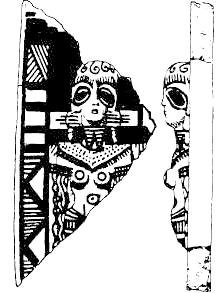
An ancient Mesopotamian depiction of one of their female
extraterrestrial “Gods.”
The “Gods” were very
humanlike with male and female bodies. The eyewear, form-fitted
clothing, and body
apparatus on the above “God” are strongly reminiscent of
modern aviator’s goggles, airtight suit, and modern gadgetry.
(Reproduced by permission from
The Twelfth Planet, by
Zecharia Sitchin.)
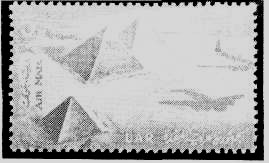
The Great Pyramid is also pointed precisely along the four compass
directions. This postage stamp issued by Egypt in 1959 shows an
airplane flying in direct alignment with the Great Pyramid, as
though to suggest that the pilot is using the pyramid to guide the
airplane.
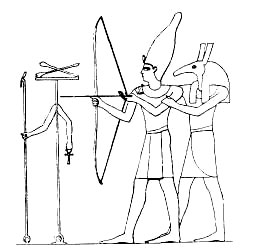
Egypt’s
Custodial “Gods” were said to participate in the up-bringing
of the pharaohs. In this Egyptian illustration we see Pharaoh
Thutmose III being given an archery lesson by one of his “Gods.”
Thutmose became famous for his military exploits.
This illustration
suggests that Custodians had a role in training humans to be
warlike.
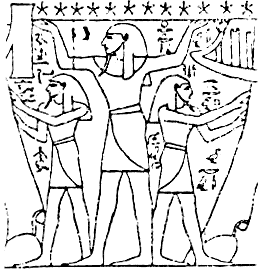
The Custodial "gods" of ancient Egypt
were very often depicted wearing aprons.
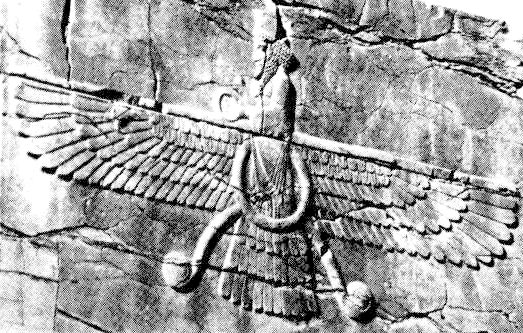
The Zoroastrian “God, “ Ahura Mazda, was depicted in ancient Persia
as a humanlike creature who flew in a circular object. The object is
depicted with stylized wings and bird’s tail to indicate that it
flies. It also had bird’s feet that look like landing struts.
Depictions such as these were not meant to be literal images of the
“God, “but were meant to portray the “God ” in such a way so as to
reveal its attributes. Zoroaster’s “God ” had the attributes of being
humanlike and flying about in a circular craft.
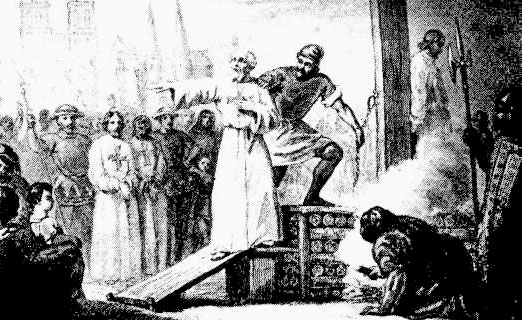
Grand Master of the Templar Knights,
Jacques de Molay, is led to a stake where he will be burned. Three
other Templar Knights also await execution. The burning took place
in Paris; in the background one can see the Cathedral of Notre Dame.
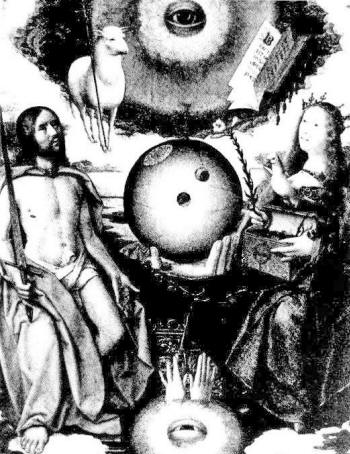
Christianity has been closely associated with Brotherhood mysticism
since the lifetime of Jesus. This painting by Jan Provost (ca.
1465-1529) is entitled, “A Christian Allegory.” It features
Christian symbols—among them the “All-Seeing Eye” of God and the
lamb. Both of these symbols were used by the Brotherhood long before
the advent of Christianity.
The “All-Seeing Eye” of God was derived
from the “Eye of Horus” symbol used in ancient Egypt. Horus
was one
of Egypt’s Custodial “Gods.“ The lamb was already symbolically
important during the reign of Melchizedek centuries before the birth
of Jesus. It was Melchizedek‘s branch of the Brotherhood that
reportedly first began to use lambskin for its ceremonial aprons.
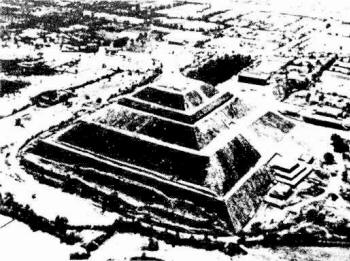
The extraordinary similarities between the ancient civilizations of
Egypt and America are too striking to be coincidence. Above is the
ancient Mexican Pyramid of the Sun, which resembles the first step
pyramid of Egypt.
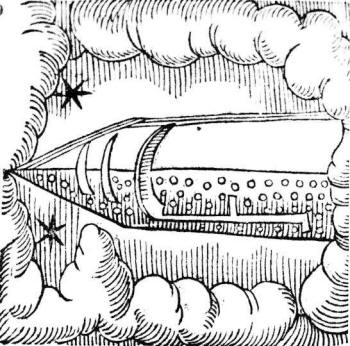
Centuries ago, almost any unusual flying object was called a
“comet.” The above is an illustration published in 1557 of a “comet”
observed in 1479 in Arabia. The comet was described as looking like
a sharply pointed wooden beam.
.
The artist’s concept, which was based
on eyewitness testimony, looks like a rocketship with numerous port
holes. Many other ancient reports of “comets” may well have been of
similar objects.
(Reproduced from 'A Chronicle of Prodigies and Portents'...
by Conrad Lycosthenes.)
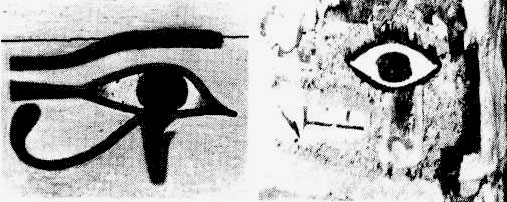
ABOVE LEFT AND RIGHT: The
similarities between ancient Old and New World civilizations are
also seen in some of the symbols used by both. Above left is the Eye
of Horus symbol found in ancient Egypt. Above right is a similar eye
found on an ancient American artifact.
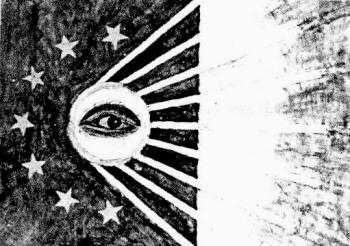
ABOVE AND BELOW: Many proposed designs were submitted for a flag for
the new Confederacy. These two proposals, which are preserved today
in the United States National Archives, prominently feature
the
Brotherhood’s symbol of the All-Seeing Eye. The Confederate leaders
eventually opted for a simple cross bars and stars design.
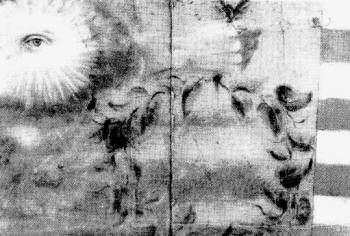
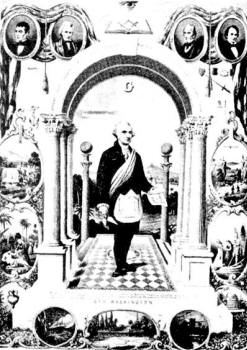
Depiction of George Washington wearing his Masonic regalia.
Despite his domestic liberalism and professed
anti-Machiavellian beliefs, Frederick proved by his actions to be as
warlike and as shrewdly manipulative in the complex web of European
politics as any man of his day. His goal was the militaristic
expansion of the Prussian kingdom. He was not above aiding
insurrection and being fickle in his alliances to achieve his goal.
In the 1740’s, Frederick had a political alliance with France.
France was actively supporting the Jacobites against the Hanoverians
and rumors circulated in London that Frederick was helping the
Jacobites prepare for their big invasion of England in 1745.
Frederick afterwards shifted his alliance back to England and
continued to profit from England’s woes. He not only gained
territory, but money as well. Sharing in Frederick’s monetary
profits were other German principalities, including Hannover
itself. They all made their money by renting German soldiers to
England at exorbitant prices. Hannover had already been engaged in
this enterprise for decades.
The rental of German mercenaries to England was perhaps one of the
great “scams” of European history: a small clique of German families
overthrew the English throne and placed one of their own upon it.
They then used their influence to militarize England and to involve
it in wars. By doing so, they could milk the British treasury by
renting expensive soldiers to England to fight in the wars they
helped to create! Even if the Hanoverians were unseated in England,
they would go home to German Hannover with a handsome profit made
from the wars to unseat them.
This may be one key to the puzzle of
why some members of this German clique supported Scottish Templar
Freemasonry and later took on leadership positions within it.
England rented German mercenaries through the signing of “subsidy
treaties,” which were really business contracts. England began
entering into subsidy treaties almost immediately after the German
takeover of their country by the House of Orange in 1688. As we
recall, one of the first things that William and Mary did after
taking the English throne was to launch England into war.
The German mercenaries were a constant burden to England. One early
mention of them is found in the correspondence of the Duke of
Marlborough.*
* Letters written by the Duke of
Marlborough are translated here into modern English.
Marlborough was an English leader fighting on the
European continent against France during the War of Spanish
Succession (1701-1714).**
**Wars of “succession” were wars sparked by
disputes over who should succeed to a royal throne. The major
European powers often got involved in these frays and turned them
into large-scale conflicts which could drag on for years.
Hannover was renting troops to England at
that time—years before Hannover took the British throne. On May 15,
1702, Marlborough discussed the need to pay the Hannoverian troops
so that they would fight:
If we have the Hanover troops, I am afraid there must be one hundred
thousand crowns given them before they will march, so that it would
be very much for the Service if that money were ready in Holland at
my coming.2
Four days later, 22,600 pounds were allocated by the English
government to pay the mercenaries.
Prussia and Hesse were also supplying mercenaries to Britain during
that war. Marlborough’s woes in getting them paid continued. Writing
from the Hague on March 26, 1703, he lamented:
Now that I am come here [the Hague] I find that the
Prussians, Hessians, nor Hanoverians have not received any of their extraordinaries [fees] .. .3
England’s next major European war was the War of Austrian Succession
(1740-1748). Frederick the Great was allied with France against
England this time. This did not stop other German principalities
from continuing their business relationship with England, especially
Hannoverand Hesse. Although Hannover now sat on the British
throne, it was not about to cease its profitable enterprise. If
anything, Hannover’s British reign gave that German principality
greater leverage to drive even harder bargains with England for
Hannoverian mercenaries.
A letter written on December 9, 1742 by
Horace Walpole, Britain’s former Prime Minister, discussed the
enormous fee England was asked to pay for renting 16,000 Hannoverian
troops:
. . . there is a most bold pamphlet come out... which affirms that in
every treaty made since the accession [to the British throne] of
this family [Hanover], England has been sacrificed to the interests
of Hanover. . .4
The pamphlet mentioned by Walpole contained these amusing words:
Great Britain hath been hitherto strong and vi[g]orous enough to bear
up Hanover on its shoulders, and though wasted and wearied out with
the continual fatigue, she is still goaded on . . . For the
interests of this island [England] must, for this once, prevail, or
we must submit to the ignominy of becoming only a money-province to
that electorate [Hannover].5
In the end, opposition to the subsidy treaties
failed. England truly
became Hannover’s “money-province.”
Lamented Walpole:
We have every now and then motions for
disbanding Hessians and
Hanoverians, alias mercenaries; but they come to nothing.6
The subsidy treaties were indeed lucrative. For example, in the
contract year beginning December 26, 1743,the British House granted
393,733 pounds for 16,268 Hannoverian troops. This may not seem like
much until we realize that the value of the pound was very much
higher than it is today. To raise some of this money, the
Parliament went as far as to authorize a lottery.
At the same time that England was fighting the War of Austrian
Succession, it was also fighting the Jacobites. More German troops
were needed on that front.
On September 12, 1745, Charles Edward of the Stuart family led his
famous invasion of England by way of Scotland. “Bonnie Prince
Charlie,” as Charles Edward was called, captured Edinburgh on
September 17 and was approaching England with the intent of taking
London. That meant more money for Hesse. On December 20, 1745,
Hanoverian King George II announced that he had sent for 6,000
Hessian troops to fight in Scotland against Charles Edward.
King
George presented Parliament with a bill for the Hessian troops. It
was approved. The Hessians landed on February 8 of the following
year. Meanwhile, back on the European front, England hired more
soldiers from Holland, Austria, Hannover, and Hesse to pursue
England’s “interests” there. The bills were staggering.
The war on the Continent finally ended. It was not long, of course,
before the rulers of Europe were involved in another one. This time
it was the Seven Years War (1756-1763)— one of the largest armed
conflicts in European history up until that time.*
* The Seven Years War was actually an expansion of the French and
Indian War being fought in North America between England and France.
The expansion of the war into Europe had been triggered by Frederick
the Great himself when he invaded Saxony.
Frederick of
Prussia had switched his allegiance back again to England, and the
two nations (England and Prussia) were pitted against France,
Austria, Russia, Sweden, Saxony, Spain, and the Kingdom of
Two Sicilies. Frederick did not ally himself to England this time out
of fickle love for Britain. England was paying him. By the Treaty of
Westminster effective April 1758, Frederick received a substantial
subsidy from the English treasury to continue his fighting, much of
it to defend his own interests! The treaty ran from April to April
and was renewable annually.
During the Seven Years War, England also paid out money
to help Hannover defend its own German interests. France had
attacked Hannover, Hesse, and Brunswick. Some of the subsidy money
paid to Hannover and Hesse was used by those principalities to
defend their own borders. The treaty with Hesse, signed on June 18,
1755 (shortly before the Seven Years War erupted) was especially
generous. In addition to “levy money” (money used to gather an
army together) and “remount money” (money used to acquire fresh
horses), Hesse was granted a yearly subsidy of 36,000 Pounds when
its troops were under German pay, and double that when they entered
British pay. An additional 36,000Pounds went directly to the coffers
of the Landgrave of Hesse.
Many English Lords did not feel that German troops were worth the
money. While discussing a possible French invasion of England,
Walpole joked,
“if the French do come, we shall at least have
something for all the money we have laid out on Hanoverians and
Hessians!”7
William Pitt, another influential English statesman,
added these amusing words to the debate:
The troops of Hanover, whom we are now
expected to pay, marched into
the Low Countries, where they still remain. They marched to the place
most distant from the enemy, least in danger of an attack, and most
strongly fortified had an attack been designed. They have,
therefore, no other claim to be paid than that they left their own
country for a place of greater security. I shall not, therefore, be
surprised, after such another glorious campaign... to be told
that the money of this nation cannot be more properly employed than in
hiring Hanoverians to eat and sleep.8
The German principality to profit most from the soldiers-for-hire
business was Hesse.
In taking a quick look at the history of Hesse, we find that after
Philip the Magnanimous died in 1567,Hesse was divided between
Philip’s four sons into four main provinces: Hesse-Kassel (often
spelled Hesse-Cassel), Hesse-Darmstadt, Hesse-Rheinfels, and
Hesse-Marburg. The most important and powerful of these four Hessian
regions became Hesse-Kassel, into which Hesse-Rheinfels and
Hesse-Marburg would later be reabsorbed.
Renting mercenaries to England became the Hessian royal family’s
most lucrative enterprise. Although Hesse itself was scarred during
some of the European conflicts, the Hessian dynasty built an immense
fortune from the soldier business. In fact, Landgrave Frederick II of
Hesse-Kassel (not to be confused with Frederick II of Prussia or
with the German emperor Frederick II of the Crusade era) made
Hesse-Kassel the richest principality in Europe by renting out
mercenaries to England during Britain’s next great struggle: the War
for American Independence, also known as the American Revolution.
Also benefiting from the American Revolution was the royal House of
Brunswick. Its head, Charles I, rented soldiers to England at a very
handsome price to help fight the rebelling colonists.
As we can see, Hesse, Hannover and a few other German states
profited handsomely from the conflicts which had beset England. The
problems of Britain gave them the opportunity to plunder the British
treasury at the expense of the English people. This had the
additional effect of pushing England into ever-deepening debt to the
new bankers with their inflatable paper money.
The populace of Germany also suffered. Most of the mercenaries rented
to England were young men involuntarily conscripted and forced to
fight where their leaders sent them. Many were maimed and killed so
that their rulers could live in greater luxury. The wealth and
influence of a small clique of German dynasties had been built upon
the blood of the young.
Lurking behind these activities we continue to find the presence of
the Brotherhood network. As the years progressed, members of the
royal families of Hesse and Brunswick emerged as leaders of the
Strict Observance. In 1772, for example, at a Masonic congress in
Kohlo, Duke Charles William Ferdinand of Brunswick was chosen to
succeed Von Hund as Grand Master of the Strict Observance.*
* With the election of Duke Ferdinand, the Strict Observance
underwent several changes. The Strict Observance was informally
called the “United Lodges.” Another congress was held ten years
later in 1782 in Wilhelmsbad (a city near Hanau in Hesse-Kassel).
There the name “Strict Observance” was dropped altogether and the
Order was thereafter called the “Beneficent Knights of the Holy
City.” The Wilhelmsbad congress officially abandoned the story that
the Templar Knights were the original creators of Freemasonry.
However, the Knight degrees were retained, as was the idea of
leadership by an “Unknown Superior.”
Several years after his election to the Grand Master
position, Duke Ferdinand succeeded Charles I as the ruler of
Brunswick and inherited the money from Brunswick’s rental of
mercenaries.
Sharing leadership duties in the Strict Observance with the Duke of
Brunswick was Prince Karl of Hesse, son of Frederick II of
Hesse-Kassel. According to Jacob Katz in his book, Jews and
Freemasons in Europe, 1723-1939, Prince Karl was later “accepted as
the head of all German Freemasons.”9
Karl’s brother, William IX, who
later inherited the principality and immense fortune of Hesse-Kassel from their father, was also a Freemason. William IX had
provided mercenaries to England when he earlier ruled Hesse-Hanau.
How important a role did the Brotherhood itself really play in
manipulating these affairs?
To determine if there truly was active
Brotherhood involvement of a Machiavellian nature, it would help to
discover if there was any single Brotherhood agent who participated
first in one faction and then in another. We would require a
Brotherhood agent traveling in all circles: from the Jacobites to
the electors of Hesse, from the King of France to Prussia.
Interestingly, history records just such an individual. We would not
normally learn of such an agent because of the secrecy surrounding
Brotherhood activity. This particular person, however, by virtue of
his flamboyant personality, his remarkable artistic talents, and his
flair for drama, had attracted so much attention to himself that his
activities and travels were noted and recorded for posterity by many
of
the people around him.
Deified by some and declared a charlatan by
others, this flamboyant agent of the Brotherhood was best known by
a false appellation: the Count of St. Germain.
Back to Contents
|












